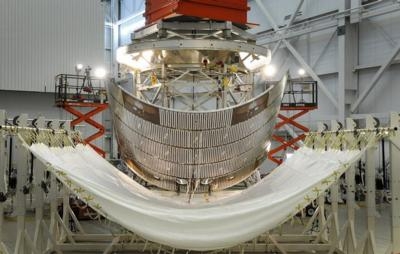Sat, Aug 01, 2015
Data From First Test Flight Makes Technology Safer, Lighter And More Reliable
Testing of design changes made to the NASA Orion spacecraft's fairing separation system have been completed by Lockheed Martin engineers. These changes resulted from data collected during Orion's first test flight on Dec. 5, 2014.

A finished Orion spacecraft has three fairings, or panels, that protect the service module radiators and solar arrays from heat, wind and acoustics during ascent into space. For the purposes of collecting data during these tests, only one fairing was separated.
The separation took about three seconds and the design changes tested were:
New push-off springs that push on the fairing for a longer period of time to provide increased safety and reliability.
As part of an ongoing mass reduction effort, the team used four crew module structural attachments instead of six.
Star trackers, or cameras that provide positioning from the stars, are used for navigation on the spacecraft. The fairing separation system pulls off the star tracker covers which prevent contamination before launch, and this process was tested for the first time.
In addition, these tests evaluated different pyrotechnic variances and higher load cases in order to prepare for Exploration Mission-1, when Orion is launched on NASA's new Space Launch System rocket. The team was also able to collect shock data, which will be provided to the European Space Agency (ESA) to support their work designing, building and testing the service module. In fact, these same fairings will be used for service module acoustics and vibe testing taking place at NASA's Plum Brook facility in Ohio later this year.
"The fairing separation is one of our very first critical events," said Mike Hawes, Lockheed Martin Orion vice president and program manager. "If it doesn't work as planned, it's probable the mission cannot continue, and tests like this help ensure it will work right the first time and every time."
(Image provided by Lockheed Martin)
More News
Aero Linx: JAARS Nearly 1.5 billion people, using more than 5,500 languages, do not have a full Bible in their first language. Many of these people live in the most remote parts of>[...]
'Airplane Bounced Twice On The Grass Runway, Resulting In The Nose Wheel Separating From The Airplane...' Analysis: The pilot reported, “upon touchdown, the plane jumped back>[...]
"Burt is best known to the public for his historic designs of SpaceShipOne, Voyager, and GlobalFlyer, but for EAA members and aviation aficionados, his unique concepts began more t>[...]
"Polaris Dawn, the first of the program’s three human spaceflight missions, is targeted to launch to orbit no earlier than summer 2024. During the five-day mission, the crew >[...]
There Are SO Many Ways To Get YOUR Aero-News! It’s been a while since we have reminded everyone about all the ways we offer your daily dose of aviation news on-the-go...so he>[...]
 ANN's Daily Aero-Linx (05.04.24)
ANN's Daily Aero-Linx (05.04.24) NTSB Final Report: Quest Aircraft Co Inc Kodiak 100
NTSB Final Report: Quest Aircraft Co Inc Kodiak 100 Aero-News: Quote of the Day (05.04.24)
Aero-News: Quote of the Day (05.04.24) Aero-News: Quote of the Day (05.05.24)
Aero-News: Quote of the Day (05.05.24) Read/Watch/Listen... ANN Does It All
Read/Watch/Listen... ANN Does It All



